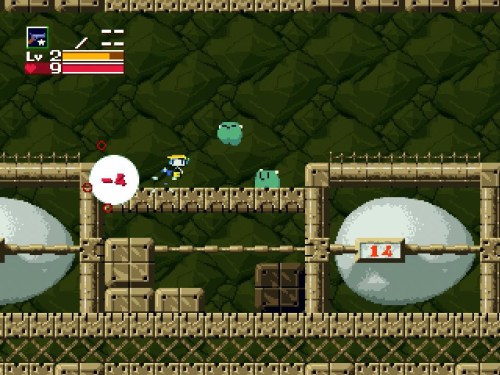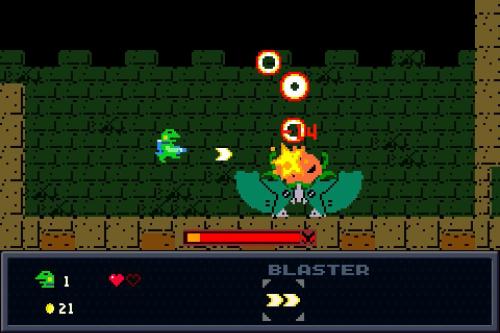Studio Pixel’s Cave Story is one of my favorite games. Created, designed, illustrated, scored, and programmed by one person — Daisuke “Pixel” Amaya — it is often credited for sparking the indie game revolution of the last decade.
It is a meticulously crafted and thoroughly fun non-linear action game, with a good story, strong characters, and wonderful 16-bit sensibilities.

Cave Story has gone on to be ported and enhanced across several different platforms, and many fans — including myself — have been eagerly awaiting his next big release.
In May of 2014 — nearly ten years after Cave Story — our wishes finally came true. With additional help from Kiyoko Kawanaka, his latest game Kero Blaster has arrived.
“Kero” is the Japanese equivalent of “ribbit” in English, and the title itself sounds like a play on “ghetto blaster”, those giant boomboxes from the ’80s. Fitting, given the oldschool graphical and musical stylings of this game.
Those going into Kero Blaster expecting Cave Story II may be slightly disappointed. If Cave Story was Amaya’s tribute to games like Super Metroid and Castlevania: Symphony of the Night, Kero Blaster is his Mega Man and Super Castlevania IV. It’s shorter and linear, but just as fun and entertaining.
At its heart, Kero Blaster is a side-scrolling action platformer with run-and-gun sensibilities. You play a no-nonsense, blue tie-wearing frog who has an acquirable double-jump ability, a sweet bomber jacket for added protection, four upgradeable weapons, and various other health boosts which can be purchased at shops throughout each of the game’s seven stages.
Your frog controls well, although I found him to be a little too — dare I say — slippery at times, but rarely did the slightly loose controls lead to my demise. His double-jump controls do take some getting used to, and will feel more natural once you understand that double-jumping straight up takes you higher than diagonal ones.
I appreciated being able to use my Xbox One controller to play this game. I remapped my controls — preferring to use the bumpers to cycle through weapons — and away I went.
The weapons at your disposal also have a range of pros and cons. Some have a limited reach, some are better in specific environments, while others are very potent, but concentrated, like Contra III‘s laser vs. spreadfire.
All of them are fun to use and look great. I utilized each of them up to the very end, which shows how much thought Amaya put into their design.
Most of the game’s levels are uniquely designed, with some asset reuse occurring during the game’s final act. This is all part of the game’s story, however, and it works extremely well in showcasing how far your little green hero has come.
Each level is fun to explore, and figuring out the best way to dispatch enemies is one of the game’s best qualities. There are also a good number of secrets to uncover — including a fifth weapon — which takes a New Game+ playthrough to acquire.
Speaking of New Game+, like many other games, you can play through the levels again with all of your gear. In Kero Blaster‘s case, however, you’ll start over with only one heart and no cash, but hey, a small price to pay for looking so cool.
In fact, New Game+ is where the game truly comes to life. It’s certainly fun the first time, but going through the levels again — without any of the cutscenes to slow things down and powered-up — is quite literally an absolute blast. There are also some extras to be had for those who play through the game at least twice.
Kero Blaster‘s visuals are wonderful. The frog you control is charmingly simplistic and flat-shaded, as are many of the creatures and characters you run into throughout the game. While they may look rather basic in screenshots, every character is animated nicely, with tons of personality, vibrant colors, and memorable design.
The world graphics are matched perfectly to its inhabitants as well, with excellent foreground and background separation, clear platforms, and smoothly scrolling playfields.
Kero Blaster‘s music and sound effects are also very good, and classic game music fans will find a lot to enjoy here. It’s not as uniquely synthy as traditional 8-bit soundtracks tend to be, but it still has its strong points, with certain tracks sticking in your head long after you’ve turned the game off.
In terms of difficulty, Kero Blaster feels just about right. It’s surprising how easy it is to take damage, and even with a decent amount of heart containers and reserves, I died quite a bit. Checkpoints throughout each level are generous, but if you lose all of your lives, you have to start the stage over from the beginning. Fortunately, you don’t lose anything in the process. A Game Over can sometimes even be a good thing as you’re able to gather more money retracing your steps, allowing easier and faster upgrades to your frog’s deadly arsenal.
I did run into some annoying bugs, like the fact that I had to manually terminate it via Windows 7’s Task Manager in order to properly close it. It wouldn’t launch again otherwise. Also, perhaps due to the number of on-screen sprites — of which there are a lot at times– the game had a tendency to chug a bit, tarnishing an otherwise very polished exterior.
Additionally, a very minor point is the English font. It gets the job done, but I don’t like the fact that the font pixels are smaller than the ones in the game itself. They don’t match, so hopefully this is something that can be updated in a future patch to really make everything cohesive.
The interface is also simplistic, with no display or sound options except for being able to choose the window size. Even going full-screen didn’t fill my entire monitor, possessing a dull gray border around all four sides.
Kero Blaster is short, at just about 5 hours for two complete playthroughs. However, it’s the kind of game you can’t stop until you’re done, and even after that, it compels you to come back and discover all of its many secrets.
While it may not have the historical significance that Cave Story did, it’s still a very fun game that represents all the best qualities of Amaya’s incredible talent.
- Graphics & Presentation: A-
Charming, simple spritework with clean and consistent background art. Good environmental variety, parallax scrolling, and trademark Pixel visual design and color. - Music & Sound Effects: B+
A very good oldschool-style soundtrack with crisp sound effects. The PC version’s sound files can be played directly with Pixel’s free audio player, which is a nice bonus. - Gameplay & Controls: B+
Solid controls and a good strafing mechanic make you one deadly amphibian. Linear design doesn’t leave a lot of room for exploring, but they do contain some hidden alcoves that take repeat playthroughs to uncover. Great weapons and enemy/boss design. - Value: B
This is a quick game that isn’t too hard, so most players will get through it the first time in about three hours. New Game+ is a lot of fun and worth playing through at least once. Cutscenes are removed on subsequent playthroughs to keep things moving at a brisk pace. For $8 ($5 on iOS), this is a good value.
Overall: B+












 It was only a few years ago that premium mobile games were the norm and not the exception. They’d cost as little as a dollar, with some “expensive” ones being $3 or more. It was a great time, since we saw so many high-quality titles with terrific style, gameplay, and content across all genres. Some of my fondest memories include games like Superbrothers: Sword & Sworcery EP, Tiny Wings, Real Racing 2, Infinity Blade, Groove Coaster, and Doodle Jump.
It was only a few years ago that premium mobile games were the norm and not the exception. They’d cost as little as a dollar, with some “expensive” ones being $3 or more. It was a great time, since we saw so many high-quality titles with terrific style, gameplay, and content across all genres. Some of my fondest memories include games like Superbrothers: Sword & Sworcery EP, Tiny Wings, Real Racing 2, Infinity Blade, Groove Coaster, and Doodle Jump. 



